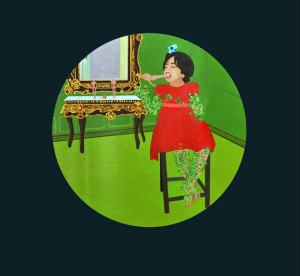Sepehr Khalili: Once confronted with this work by Soraya Sharghi, perhaps the viewer is dragged by logic of Alice’s story across this green room, and more importantly, through the cruel and evil Alice herself. In this painting, the artist draws attention precisely to the figure of the child which is the focal point of her work framed within a circle. The circle replaces the frame and turns into an opening. i.e. the child’s hiding place or passage.
In his Logic of the Sense Gilles Deleuze portrays a schizophrenic young dreamer. To her, Alice is a girl who penetrates the surface and appearance of the world around her. It is as if the concept of ‘child’ to Sharghi equals travelling on the surface for Carroll’s Alice. The difference is that a child’s body for Sharghi is a locus turning nature—the surfaces of the world of fantasies—imitable. Instead of transforming the green room into a jungle, the childish fantasies in Sharghi’s work turns the child’s body into a plant-like figure. This is why it could be said that Sorayya Sharghi invites us from a keyhole—the framed passage—to observe childish fantasies instead of portraying such fantasies in a wonderful infinite realm. In fact, her painting is a psychoanalytic recording of a little girl’s fantasy.

